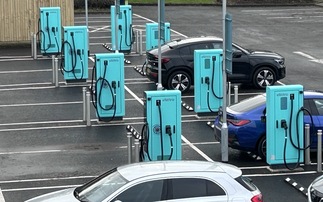Credit: iStock
Battery deployment in the power sector is surging to record levels worldwide, but still needs to increase six-fold to meet COP28 2030 climate and energy goals, according to the IEA
Battery deployment in the power sector more than doubled last year, outpacing almost all other clean energy technologies as falling costs, advancing innovation, and supportive industrial policies helped drive a surge in global demand.
That is the headline finding from the , according to the International Energy Agency's (IEA) latest market report on the global battery sectors, published yesterday. However, the update also warns that in order to meet the world's 2030 climate and energy security goals, batteries still need to lead a six-fold increase in global energy storage capacity through to the end of the decade.
The report said the deployment of batteries would be "critical to delivering the climate and energy targets outlined at the COP28 climate conference in Dubai".
While lithium-ion batteries were previously associated with consumer electronics, they are now a major player in the energy sector where the technology accounts for more than 90 per cent of overall battery demand, the report states.
In 2023 alone, battery deployment in the power sector increased by more than 130 per cent year-on-year, adding a total of 42GW to electricity systems around the world, according to the IEA.
The demand from the power sector is matched by the auto industry where batteries have enabled electric car sales to surge from three million in 2020 to almost 14 million last year, with further strong growth expected in the coming years.
The boom in demand for batteries has been driven by cost reductions, which have seen battery costs fall more than 90 per cent over the past 15 years, the IEA said.
"The electricity and transport sectors are two key pillars for bringing down emissions quickly enough to meet the targets agreed at COP28 and keep open the possibility of limiting global warming to 1.5C," said IEA executive director Fatih Birol.
"Batteries will provide the foundations in both areas, playing an invaluable role in scaling up renewables and electrifying transport while delivering secure and sustainable energy for businesses and households. The combination of solar PV and batteries is today competitive with new coal plants in India. And just in the next few years, it will be cheaper than new coal in China and gas-fired power in the United States. Batteries are changing the game before our eyes."
Even so, the IEA warns that battery deployment still needs to "scale up significantly" between now and the end of the decade to put the world on track for its energy and climate goals.
It estimates that if overall energy storage capacity increases six-fold between now and 2030, batteries would need to account for 90 per cent of that increase in capacity, with pumped hydropower providing the remaining 10 per cent.
By enabling greater shares of renewables in the power system and shifting electricity supply to when its most needed, batteries will help to advance progress towards the goals agreed at COP28 last year, including targets to triple renewable power capacity by 2030, double the pace of energy efficiency improvements by 2030, and transition away from fossil fuels.
To triple global renewable energy capacity by 2030, IEA estimates 1,500GW of battery storage will be required, warning that a shortfall in deploying energy storage capacity would risk stalling clean energy transitions in the power sector.
To scale up batteries globally, the report found that costs need to continue to come down without compromising on quality or technology.
It added that ensuring energy security will also require greater diversity in supply chains, including for extracting and processing the critical minerals used in batteries, and for manufacturing the batteries themselves.
The report notes that countries are already tackling potential supply chain risks through industrial programmes to support local manufacturing capacity with targeted policies in the US, EU, and India, among others.
Global battery manufacturing has more than tripled in the last three years, according to the report. While China was found to be the largest producer of batteries today, the report also shows that 40 per cent of announced plans for new battery manufacturing is in advanced economies such as the US and the European Union.
The report estimates that if all those projects are built, those economies would have nearly enough manufacturing to meet their own needs through to 2030 in line with a net zero compatible decarbonisation trajectory.
Moreover, the report highlights how batteries have potential to help 400 million people in emerging and developing economies gain electricity access through decentralised solutions such as solar home systems and mini grids with batteries.
In related news, fresh figures from BloombergNEF published yesterday have found that the global energy storage market is "growing faster than ever" and "showing no signs of slowing".
In its latest Energy Storage Market Outlook report, BloombergNEF found that in 2023 deployments came in at 44GW/96GWh, which is a near 300 per cent increase from 2022, marking the largest ever year-over-year rise for energy storage additions.
The analysis projects further robust growth this year, with potential for 67GW/155GWh to be added throughout 2024, which would mark a 60 per cent increase in gigawatt-hour terms.
Over the rest of the decade, the report forecasts an annual growth rate in energy storage capacity of around 21 per cent through to 2030.
For comparison, the report notes that the global solar and wind markets are expected to enjoy respective annual growth rates of 8.9 per cent and 6.6 per cent in the same period.
Global growth is largely being driven by China, which BloombergNEF expects to retain its position as the largest energy storage market globally this year.
The next largest-market is set to be the US, where BloombergNEF highlights a combination of state targets, utility procurements, and attractive merchant economies in places such as Texas as the main driver of growth.
In regions such as Europe, the Middle East and Africa, meanwhile, residential batteries are set to be the largest source of energy storage demand, led by the German and Italian markets, and followed by Austria, Switzerland, Belgium, Sweden, Spain and the UK, according to the report.
Government mandates and targeted subsidies are still the main drivers of project development, according to the report. These include solar and wind co-location mandates in China, the Inflation Reduction Act and state-level policies in the US, as well as new support schemes emerging across Europe, Australia, Japan, South Korea and Latin America.
Moreover, the report suggests that falling energy storage costs - as seen in China - can help support more economic deployments globally. However, it cautioned that it remains "unclear" as to whether recent cost declines in China - particularly for cheaper lithium ion phosphate (LFP) batteries - can continue to be achieved at the present rate, and whether it can continue to drive down costs on the global market.
Want to understand what is going on at the cutting edge of sustainability? Check out BusinessGreen Intelligence - the premier information for professionals focused on the UK's green economy.







